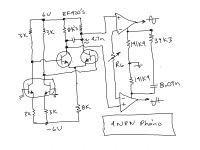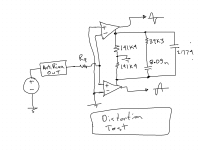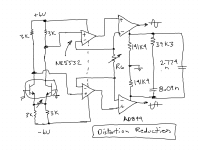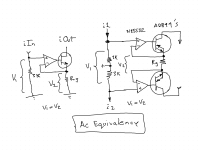The 2N5542 you mentioned is a NPN power transistor, so I used the good old 2N3819.
Distortion now with a 2K25 Rg giving the same overall 72dB gain, went slightly up from 0.0259 to 0.0266.
So, no improvement in that dept.
And just for completeness, I went back and also tried the PNP Mat03 (so, without the additional Fet's.)
I had to change Rg from 810 to 765 to keep the gain at 72dB.
Noise went even up from 63.4nV to 66.7nV and so did the THD to 0.0271, both most likely the consequence of a lower Rg.
Of course, this all depending on AD's correctness of the Mat02 and Mat03 spice models.
Hans
Distortion now with a 2K25 Rg giving the same overall 72dB gain, went slightly up from 0.0259 to 0.0266.
So, no improvement in that dept.
And just for completeness, I went back and also tried the PNP Mat03 (so, without the additional Fet's.)
I had to change Rg from 810 to 765 to keep the gain at 72dB.
Noise went even up from 63.4nV to 66.7nV and so did the THD to 0.0271, both most likely the consequence of a lower Rg.
Of course, this all depending on AD's correctness of the Mat02 and Mat03 spice models.
Hans
Thanks Hans. Again interesting. The FET might have been a 2n5545... my new eyes seem not so good.... or perhaps more likely the brain is becoming more defective...
The jfet devices were replaced and tested with a pair of BF420 NPN devices. As expected the gain is high and problematic (though the DC servos added to the network handled the offsets nicely to the millivolt level). The gain suggests limited high frequency headroom on the collectors. However the Rg value could be set much higher (5 kOhm was used to cause near 4 VRMS 1kHz 5 cm/sec as I recall). Given your results I don't know if distortion would improve, perhaps making the exercise pointless. It seems the distortion may only be improved by a load reduction (increasing resistance values and lower capacitance) of the RIAA network.
To control the headroom the 75uSec pole was moved to the interstage collectors as the signal levels are now considerable higher than on the input collectors. Of note, however, frequencies above the pole no longer attenuate harmonic distortions/noise internal to the AD844's. Given that there exists 4 NPN's this suggests using the THAT devices (though no real reason not to use two Mat devices or SSM's), particularly in that the lowest noise device also has the lowest gain and nicely the only one available in a DIP package. In practice this may require adding some emitter resistance in the legs of the secondary stage to reduce the interstage gain farther from itself overloading.
https://www.mouser.ca/datasheet/2/407/THAT_300-Series_Datasheet-180059.pdf

The jfet devices were replaced and tested with a pair of BF420 NPN devices. As expected the gain is high and problematic (though the DC servos added to the network handled the offsets nicely to the millivolt level). The gain suggests limited high frequency headroom on the collectors. However the Rg value could be set much higher (5 kOhm was used to cause near 4 VRMS 1kHz 5 cm/sec as I recall). Given your results I don't know if distortion would improve, perhaps making the exercise pointless. It seems the distortion may only be improved by a load reduction (increasing resistance values and lower capacitance) of the RIAA network.
To control the headroom the 75uSec pole was moved to the interstage collectors as the signal levels are now considerable higher than on the input collectors. Of note, however, frequencies above the pole no longer attenuate harmonic distortions/noise internal to the AD844's. Given that there exists 4 NPN's this suggests using the THAT devices (though no real reason not to use two Mat devices or SSM's), particularly in that the lowest noise device also has the lowest gain and nicely the only one available in a DIP package. In practice this may require adding some emitter resistance in the legs of the secondary stage to reduce the interstage gain farther from itself overloading.
https://www.mouser.ca/datasheet/2/407/THAT_300-Series_Datasheet-180059.pdf

Last edited:
Hi Hans. Can you do a distortion test for the network below using 810 Ohms for Rg and adjust the signal level to produce the same level output as before? Note that this includes the AntiRiaa that seems excluded from the previous tests. I used RIAA values you found previously.
In the continuation use perhaps 5 kOhm and readjust the signal level for the same output? What I'm looking for is the degree the inverting terminal Ro's are creating distortions.

In the continuation use perhaps 5 kOhm and readjust the signal level for the same output? What I'm looking for is the degree the inverting terminal Ro's are creating distortions.

Last edited:
I’m not sure what you are asking with this 5K resistor, but be assured that the all THD test where done including the Riaa network.
Since you are still full of ideas I think it would be a good idea just now to start using LTSpice yourself.
I’ve spent quite some time with pleasure but this has to stop somewhere, right ?
I will be there in the background all time.
The LTSpice model is attached for you to take over.
Hans
Since you are still full of ideas I think it would be a good idea just now to start using LTSpice yourself.
I’ve spent quite some time with pleasure but this has to stop somewhere, right ?
I will be there in the background all time.
The LTSpice model is attached for you to take over.
Hans
Attachments
Oh noooo. It become too much.... I do understand that Hierfi was very playful, and that Hans was just providing services all the time. But lets not end this story! Hans , we need you, and not for your service, but for your expertise !
On my side I'm learning heaps here, and will not stop now when in mood, thanks to all for instructions!
@ Hierfi, we both must learn how to effectively use tools available, point!. It is bit overwhelming what can be done today versus decades ago, lots of work, but obviously needs to be done for for being contemporary in this hobby.... I'm in process of setting basic for myself too...
@ Hans , you did a lot of work for our ideas, but what about your own, there was this unfinished project, and also your own preamp, sharing details?
Love,
Dražen
On my side I'm learning heaps here, and will not stop now when in mood, thanks to all for instructions!
@ Hierfi, we both must learn how to effectively use tools available, point!. It is bit overwhelming what can be done today versus decades ago, lots of work, but obviously needs to be done for for being contemporary in this hobby.... I'm in process of setting basic for myself too...
@ Hans , you did a lot of work for our ideas, but what about your own, there was this unfinished project, and also your own preamp, sharing details?
Love,
Dražen
Drbulj, Thx for your friendly reaction.
Sometimes one needs to being slightly pushed, all from a positive intention.
After having taken the first hurdles in using LTSpice, a whole new world opens, giving lots of satisfaction.
But I will be most happy to assist whenever problems are encountered in using LTSpice.
You mentioned an unfinished project, what posting are you referring to ?
Was it my headamp project, or was it the complete Riaa MC amp as published in Linear Audio?
Both project have been finished long ago.
Hans
Sometimes one needs to being slightly pushed, all from a positive intention.
After having taken the first hurdles in using LTSpice, a whole new world opens, giving lots of satisfaction.
But I will be most happy to assist whenever problems are encountered in using LTSpice.
You mentioned an unfinished project, what posting are you referring to ?
Was it my headamp project, or was it the complete Riaa MC amp as published in Linear Audio?
Both project have been finished long ago.
Hans
I will be there in the background all time.
I do things that are fun Hans... stop when they are not... go into hiding with my critically selected essentials of life... and hope my wife doesn't find me and forces me back to work.
Although the results of the analysis would be interesting it is doubtful that I would be getting much out of it either, as the outcome seems mostly predictable. The reason for the continuation was that Drbulji questioned the nature of the distortion results from your previous analysis, being so dramatically split between even and odd. So it was that the intention was to simplify the presentation and advance discussions focused more specifically to the cause of distortions that Drbulji was questioning. There was no intention to use you in some way disrespectful because I was being too lazy to do it myself Hans... though it is true that I am lazy... as my wife can surely emphasize.
Sitting in the background (though not all time) is something I can do as well. After reading your post last night it occurred to me if our interactive engagement was of much value in the context of others, hence examined the extent this thread was viewed. It is at 21,000. To whatever degree this is important, it at least shows that individuals (as Drbulji has expressed above), find the engagement in this thread interesting and hopefully useful.
Sorry Hans, as usual I mixed things up, I remembered Bonsai's project that is unfinished, mixed it up with you. It was this one: https://www.diyaudio.com/community/threads/low-noise-balanced-mc-pre.379210/post-6841752You mentioned an unfinished project, what posting are you referring to ?
Hi, in good mood I would like to move a bit from details, go back to fundamentals and ask your opinion, no any work needed: What is actual purpose of hunting for lowest noise possible? In particular by using trans impedance circuits?
While it does offer lower noise, at the same time I noticed (comparing to "usual " voltage configuration) :
To support , I recorded 2 peaks:
1. Bottom trace is my complete preamp (reminder it is with common SSM2017 mic amps in parallel, in "normal" voltage mode) and arm resting above LP
2. Top trace is all the same but stylus playing "silent groove" (between tracks 4 and 5 on brand new Ortofon test LP).

Hmmm 🤔 , there is about 30db difference in the noise. How bad the preamp should be that its noise is not masked by stylus+LP noise?
Might be I again did some technical mistakes in measurements or in understanding, but pls forgive me and look at 30db difference.
LoL, (means Lots of Love, not Lots of Laughter)
Dražen
While it does offer lower noise, at the same time I noticed (comparing to "usual " voltage configuration) :
- it increases THD
- source impedance is crucial if FB is used, so amp is dedicated to a chart (unless many switches are used to adjust FB resistors)
- what is risk assessment that cart will be BBQ-ed by DC, particularly in power up. down phases? I thing Craig mentioned this risk somewhere earlier. With cart connected to bases of transistors it is safe.
To support , I recorded 2 peaks:
1. Bottom trace is my complete preamp (reminder it is with common SSM2017 mic amps in parallel, in "normal" voltage mode) and arm resting above LP
2. Top trace is all the same but stylus playing "silent groove" (between tracks 4 and 5 on brand new Ortofon test LP).
Hmmm 🤔 , there is about 30db difference in the noise. How bad the preamp should be that its noise is not masked by stylus+LP noise?
Might be I again did some technical mistakes in measurements or in understanding, but pls forgive me and look at 30db difference.
LoL, (means Lots of Love, not Lots of Laughter)
Dražen
My daughter used lol... and didn't no what that meant... she said "laugh out loud"... now I am so confused... as always..
A colleague of mine from Manchester told me (long time ago) that his soon is often saying BOOK, finally he asked him and it is apparently meaning COOL, On old phones letters C and B, also K and L where on the same button, kids did not care to correct and cool become book 🙂
Well, basically it's quite simple.Hi, in good mood I would like to move a bit from details, go back to fundamentals and ask your opinion, no any work needed: What is actual purpose of hunting for lowest noise possible? In particular by using trans impedance circuits?
While it does offer lower noise, at the same time I noticed (comparing to "usual " voltage configuration) :
- it increases THD
- source impedance is crucial if FB is used, so amp is dedicated to a chart (unless many switches are used to adjust FB resistors)
- what is risk assessment that cart will be BBQ-ed by DC, particularly in power up. down phases? I thing Craig mentioned this risk somewhere earlier. With cart connected to bases of transistors it is safe.
Preamp noise with Cart connected should be at least 6dB below surface noise, more is better,
Since LP noise at it's best has an equivalent noise slightly below 60dBA, your preamp plus Cart should at least >65dBA, but more than 75dBA makes no sense.
That Trans impedance increases THD is completely dependent on the circuit you use, there is no other reason why THD should increase, but yes the setting has to be changed for every other Cart.
In a well designed circuit, as there are several, risk of frying your Cart can be prohibited at switch on and off, but this is a serious item to consider in the design.
In the end it is just the sound reproduction that should enable you to choose between voltage or trans impedance amplification.
My personal favorite is trans impedance, giving a wider sound stage.
But that is with my gear and with my subjective taste.
Hans
P.S. To come to that conclusion, I made a headamp that could be used in both configurations with exactly the same components.
So everything being the same, made it possible to come to a well funded choice.
After a number of iterations of variant alternatives the following was realized as a simplistic network intended for distortion reduction, simply adding an NE5532 between the input LTP and the AD844. This inclusion has several advantages, being expected to also diminish noise slightly given the NE5532 is a lower noise device than the AD844's.
This also permits attachment of the power supplies of the NE5532 back to the 6 volt supply given its operation only at low signal levels (hence can't be overloaded voltage wise). These supplies are intended created as the lowest noise supply in response to signal levels being the lowest on the supplies of the LTP. In so doing this minimizes power supply noise injection created by capacitance coupling from the supplies of the NE5532's back on the positive input terminals attached to the 3k load resistances of the LTP.
A caveat of the AD844's is that the positive input terminal is of more complex structure than shown in its equivalent circuit, that as a result operates better with lower impedance drive, a situation that in being driven from the low output impedance of the NE5532 this has an advantage to address.

This also permits attachment of the power supplies of the NE5532 back to the 6 volt supply given its operation only at low signal levels (hence can't be overloaded voltage wise). These supplies are intended created as the lowest noise supply in response to signal levels being the lowest on the supplies of the LTP. In so doing this minimizes power supply noise injection created by capacitance coupling from the supplies of the NE5532's back on the positive input terminals attached to the 3k load resistances of the LTP.
A caveat of the AD844's is that the positive input terminal is of more complex structure than shown in its equivalent circuit, that as a result operates better with lower impedance drive, a situation that in being driven from the low output impedance of the NE5532 this has an advantage to address.

Last edited:
It’s an interesting idea, completely overuling the diamond input buffer with it’s ca 50R output resistance.
Now only Rg determines the current flowing.
Hans
Now only Rg determines the current flowing.
Hans
It’s very easy to arrange to limit the current to the front end stage so that in the event one of the devices pops and goes short to the supply rail, the current is no more than 4 or 5 mA.
For noise, my personal view is if you are sitting in your normal listening position and the stylus is off the vinyl, even at close to full volume it should be quiet or unobtrusive. I’ve built MM phono stages earlier in my audio life that hissed very badly with the stylus lifted.
For noise, my personal view is if you are sitting in your normal listening position and the stylus is off the vinyl, even at close to full volume it should be quiet or unobtrusive. I’ve built MM phono stages earlier in my audio life that hissed very badly with the stylus lifted.
This would probably have been more clearly illustrated to others if the AD844 was depicted as an Operational Transconductance Amplifier or OTA as per below Hans. This form of linearization is really nothing new... being more or less identical to DC applications in linear voltage to current conversions using feedback taking the first form. Its what gave me the idea.It’s an interesting idea, completely overuling the diamond input buffer with it’s ca 50R output resistance.
Now only Rg determines the current flowing.

A very short but solid indication is that the THD with Hierfi’s proposal drops by more than a factor 40.
But Hierfi will show the exact figures while still trying to find his way into LTSpice.
Hans
But Hierfi will show the exact figures while still trying to find his way into LTSpice.
Hans
Hi Bonsai, good to see you!
Well, basically it's quite simple.
Preamp noise with Cart connected should be at least 6dB below surface noise, more is better,
Since LP noise at it's best has an equivalent noise slightly below 60dBA, your preamp plus Cart should at least >65dBA, but more than 75dBA makes no sense.
Both above criteria are excellent and very valid IMO, and not so difficult to achieve, concluding that hunt for super low noise just presents good numbers to look at, but that is it, no real improvement in reproduction of music from vinyl.... Personally I find 50Hz pickup from environment much more annoying than electronic noise, hence focus on PS, CMRR and shielding.For noise, my personal view is if you are sitting in your normal listening position and the stylus is off the vinyl, even at close to full volume it should be quiet or unobtrusive. I’ve built MM phono stages earlier in my audio life that hissed very badly with the stylus lifted.
- Home
- Source & Line
- Analogue Source
- Fully balanced MC phono preamplifier thoughts